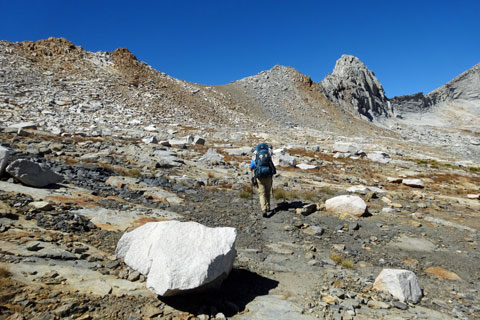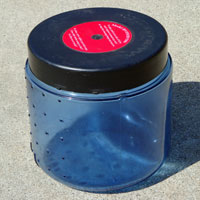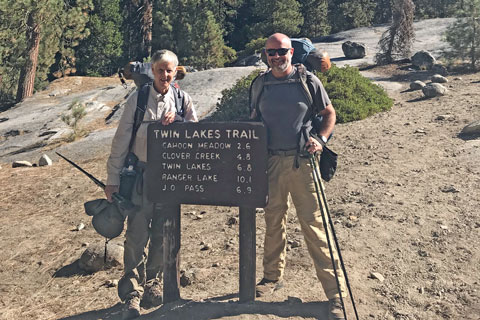Elizabeth Pass Loop Trail
Lodgepole to Crescent Meadow
A 49-mile loop trail up Deadman Canyon and across rugged Elizabeth Pass takes backpackers on a tour of some of the most remote and breathtaking wilderness terrain in Kings Canyon and Sequoia national parks. Beginning in Lodgepole in Sequoia National Park, the trail climbs to Silliman Pass and into Kings Canyon National Park, there descending to Roaring River. The adventure begins in earnest at the mouth of magnificent Deadman Canyon - a 9-mile-long valley of beautiful meadows, tumbling waterfalls, and soaring granite peaks. At the head of the canyon waits 11,200-foot Elizabeth Pass.

Approaching Elizabeth Pass
While the trail on the northern side of the pass is well-maintained, conditions deteriorate rapidly on the southwestern descent. Eventually the trail seems to disappear altogether, leaving hikers to navigate with a combination of maps, GPS, and intuition. Eventually the route connects with the High Sierra Trail and leads down to Crescent Meadow, a short shuttle bus ride away from the starting point at Lodgepole Village.
Elizabeth Pass Loop - Key Facts
Location: Sequoia & Kings Canyon national parks
Trailhead: Lodgepole, elevation 6,750 feet
First pass: Silliman Pass, 10,160 feet
Lowest point (midway): Sugarloaf Creek, 7,120 feet
Highest point: Elizabeth Pass, 11,200 feet
Crescent Meadow: 6,695 feet
Hiking Distance: 49 miles
Best seasons: Mid-summer through fall


Ranger Lake
Wildlife
Bears are common along the trail. The use of bear canisters and bear boxes has greatly reduced the problem of bears invading campsites in search of food.
Read more about bear canisters on the Elizabeth Pass Trail & Map page.
Deer are used to seeing people on the trail. Watch for them especially along Sugarloaf Creek. Rattlesnakes have been sighted along the final part of the trail from Bearpaw Meadow to Crescent Meadow. Always be watchful.
Mosquitoes are annoying in early summer and gradually taper off through August. Watch for marmots sunning on the rocks as you ascend Elizabeth Pass. Keep an eye open for shy gray foxes along the western slope, especially at lower elevations.


